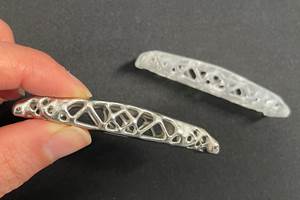How Trivalent Chrome Compares to Hexavalent
Columbia Chemical’s Mark Schario explains how the performance of trivalent chromium compares to hexavalent chromium, and what is needed to make the change to tri-chrome plating.
Q. I’m getting pressure to eliminate my decorative hexavalent chromium plating process primarily due to the high cost of waste treatment and regulatory changes. To add to it, we have troubles with HCD burning and whitewash, which increases our scrap rate. Can you tell me how the performance of trivalent chromium will compare to hexavalent chromium and what is needed to make the change?
A. Recent regulations and performance requirements are making the switch from decorative hexavalent chromium plating to trivalent chromium plating a necessity. With hexavalent chromium plating set to be eliminated in the European Union by 2021, many manufacturers; especially global manufacturers, have already specified or are in the process of specifying trivalent chromium on their plans to meet the new regulations. OSHA and the EPA continue to adopt legislation that further justifies switching from hexavalent to trivalent chromium plating. However, much hesitation still exists regarding the switchover to trivalent chromium due to concerns about performance, cost and the overall logistics of the conversion.
From a testing performance standpoint, trivalent chromium has already been used in exterior applications in the trucking industry for the past 30 years. The sulfate/chloride process has shown indefinite electrolyte life, process stability, ease of use, and excellent exterior corrosion performance. The field performances of trivalent chromium confirm test results performed by ASTM. The recent testing by USCAR has also confirmed these results. From an operational performance standpoint, throwing power is much better with trivalent chromium. Trivalent chromium is also extremely forgiving with respect to current interruption (this feature eliminates the occurrence of white wash commonly experienced with hexavalent chromium). The advantages of improved covering power and uniform thickness have eliminated the need for use of auxiliary anodes for plating difficult geometries.
When looking to make the transition from hexavalent to trivalent chromium plating, the best place to start is to recognize that not all trivalent chromium plating systems are equal. It is best to research the variety of trivalent chromium plating processes available to match the one that will best meet your needs and that of your customers. You will want to evaluate finish color, speed, control, needed equipment and, perhaps most important, is the level service and support you will receive in advance of and during the conversion itself as well as after as you continue to work with the process.
The first portion of the actual conversion process involves pumping out the hexavalent chromium solution, removing the anodes, taking apart the bussing and removing the tank liner. Following that, you cut off the exhaust hood and rinse the remaining ductwork. The tank will need leached to remove all traces of hexavalent chromium (this is a critical step). Next, rinse the tank and all associated equipment in the area to complete the removal phase of the hexavalent chromium. Now you will install the new liner and then install the graphite anodes and copper bussing. Complete the installation process by installing the air agitation, cooling and heating, and new ductwork. At this point you can fill the tank with water then acidify to operating pH and use the applicable wetting agent to be used for the process to leach all new equipment. Make up a new plating bath as directed by the manufacturer and turn on the properly prepared ion exchange. Run your initial lab tests, begin plating and scale up accordingly.
Although there is an initial time and cost investment involved in the conversion from hexavalent chromium to trivalent chromium, the benefits quickly and increasingly overcome the drawbacks. Improved production efficiency, decrease in rejects, substantial savings in wastewater treatment and improvements in employee safety are among the key advantages. Once the transition has been made, many shops quickly realize the positive impact to their operations.
Mark Schario is executive vice president at Columbia Chemical. Visit columbiachemical.com.
Related Content
Advantages to Pumped Eductor Agitation
Not all agitation methods are created equally. Pumped agitation with eductor nozzles can improve process tanks and quickly show a reduction in operating costs while keeping staff safe, following environmental legislation and preventing pollution.
Read MorePossibilities From Electroplating 3D Printed Plastic Parts
Adding layers of nickel or copper to 3D printed polymer can impart desired properties such as electrical conductivity, EMI shielding, abrasion resistance and improved strength — approaching and even exceeding 3D printed metal, according to RePliForm.
Read MoreHow to Choose Between Sulfate and Chloride-Based Trivalent Chromium
There are several factors to consider when choosing between sulfate and chloride-based baths for trivalent chromium plating. Mark Schario of Columbia Chemical discusses the differences and what platers should keep in mind when evaluating options.
Read MoreTrivalent Chrome Overview
As the finishing industry begins to move away from the use of hexavalent chromium to trivalent chromium, what factors should finishers consider as they make new investments? Mark Schario, chief technology officer for Columbia Chemical offers a helpful overview of this complicated topic.
Read MoreRead Next
Episode 45: An Interview with Chandler Mancuso, MacDermid Envio Solutions
Chandler Mancuso, technical director with MacDermid Envio discusses updating your wastewater treatment system and implementing materials recycling solutions to increase efficiencies, control costs and reduce environmental impact.
Read MoreDelivering Increased Benefits to Greenhouse Films
Baystar's Borstar technology is helping customers deliver better, more reliable production methods to greenhouse agriculture.
Read MoreEducation Bringing Cleaning to Machining
Debuting new speakers and cleaning technology content during this half-day workshop co-located with IMTS 2024.
Read More











.jpg;maxWidth=300;quality=90)













